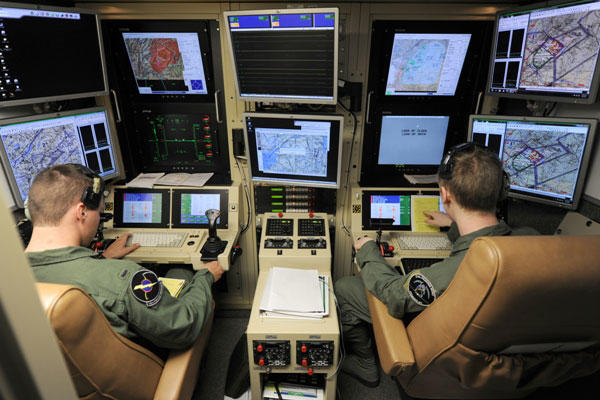The U.S. Air Force is more than doubling special pay for some drone pilots to $1,500 a month -- a move designed to address a personnel shortage in the highly stressed workforce.
Air Force Secretary Deborah Lee James announced the service will increase monthly incentive pay for senior operators of so-called remotely piloted aircraft, or RPAs, from about $600 a month to $1,500 a month.
"I just signed the memo earlier today," James said during a State of the Air Force briefing Thursday at the Pentagon, though she didn't specify how soon the additional money will be available for qualifying airmen. It would target those who have finished their initial six-year service commitment.
Unlike pilots of manned aircraft, pilots of the service's MQ-1 Predator and MQ-9 Reaper drones aren't currently eligible for aviation continuation pay of as much as $25,000 a year. While officials are working to change that policy, James said as an interim solution she exercised her authority to offer the increased monthly incentive pay.
"We will also explore more permanent incentive plans," she said.
James said she made the decision after visiting with crews over the past year at Creech Air Force Base in Nevada, the service's headquarters for drone missions overseas, where she learned firsthand of the stresses facing the workforce.
One RPA pilot who e-mailed Military.com was skeptical of how many pilots would be eligible to receive the additional pay -- perhaps less than 10 percent of the total workforce. "I assure you that the majority of us aren't getting more than the $206 as everyone else has left the field," he wrote. "We're so undermanned, it's unbelievable."
Beyond pay, the service also plans to mobilize more members of the Reserves and National Guard to help man active-duty RPA units, encourage airmen who volunteered to fly Predators and Reapers in the past to return to the units, and delay allowing pilots who are authorized to fly both manned and unmanned aircraft to leave the drone units.
The Defense Department planned to spend about $5 billion on unmanned systems in fiscal 2015, the vast majority for unmanned aerial systems, or UAVs, according to a report. The Pentagon has more than 200 Predators and more than 100 Reapers, which can also be used for strike missions and are made by General Atomics Aeronautical Systems Inc., based in San Diego.
There are nearly 1,000 active-duty pilots for Predators and Reapers, though more than 1,200 such pilots are needed.
The workforce has been stressed for years as commanders in Afghanistan and other combat zones demanded more intelligence, surveillance and reconnaissance from drones, the officials said.
The number of drone 24-hour combat air patrols, or CAPs, more than doubled from 21 in 2008 to some 65 today, according to Air Force Chief of Staff Gen. Mark Welsh. The plan had been to drop the number to 55, but that was impossible after the U.S. launched airstrikes last year against Islamic militants in Iraq and Syria.
"Our crew force will tell you, they enjoy the mission ... they're just worn out," he said during the briefing. "The crisis now is with the pilot force ... because we're reaching the point where some of them can go."
The Air Force currently trains about 180 remotely piloted aircraft operators a year, but needs about 300 of them and loses about 240 due to attrition, Welsh said. Even the training units are chronically understaffed because many trainers are pulled from operational units, he said.
The service is considering following the Army in allowing non-commissioned officers fly unmanned aircraft, Welsh said. It’s looking at encouraging pilots from services that are divesting aviation assets to move into the RPA field, he said.
Neither Welsh nor James specified how much the retention effort might cost, but said it would have to be funded in an annual appropriation going forward.
"We have just got to get ahead of this," Welsh said.
The Associated Press contributed to this report, which was updated to clarify which airmen are eligible for the new incentive pay and to include additional quotes from a drone pilot.
-- Brendan McGarry can be reached at brendan.mcgarry@military.com



























